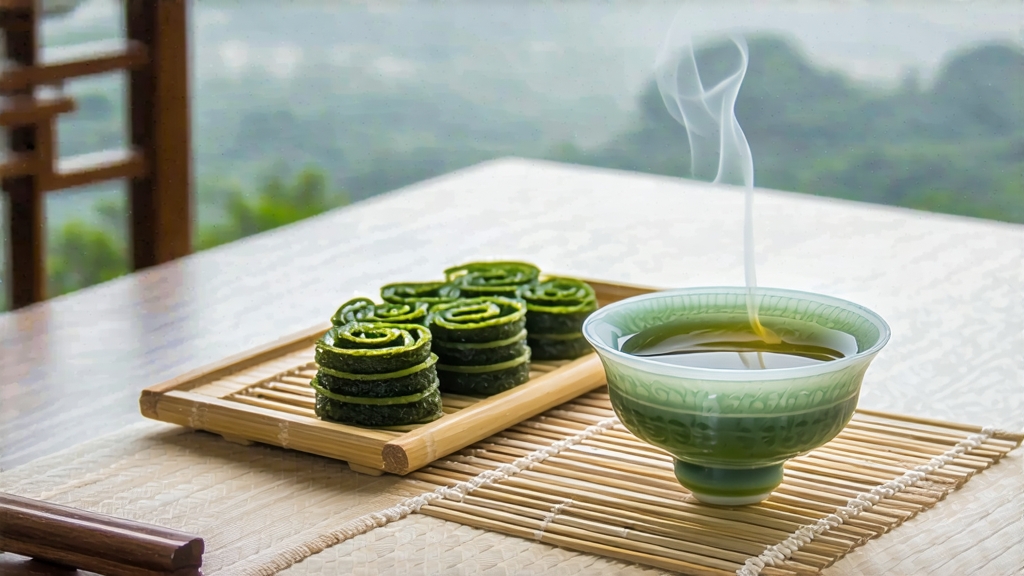
Tucked between the mist-laden slopes of Dongting Mountain in Jiangsu Province and the vast, fish-teeming waters of Lake Tai, Biluochun—literally “Green Snail Spring”—has captivated Chinese scholars, emperors, and poets for over a millennium. To the global tea traveler it offers a masterclass in delicacy: a liquor the color of early morning sunlight, a perfume that oscillates between white peach and fresh-cut grass, and a finish so cooling it feels as though one has inhaled the lake breeze itself. Yet beyond its charm lies a story of ecological serendipity, imperial accident, and craftsmanship so refined that a single kilogram demands the plucking of fourteen thousand buds, each one curled by hand into a miniature jade snail.
Historical whispers place Biluochun’s birth during the late Tang dynasty, when monks on Dongting’s East and West peaks cultivated tea to stay alert through marathon sutra recitations. Locals called it “Xia Sha Ren Xiang”—“Scary Fragrance”—because its aroma was so arresting that even passing boatmen would leap ashore to discover the source. Legend claims the Kangxi Emperor, touring the south in 1699, sampled the tea, found its name inelegant, and rechristened it Biluochun for its spiral shape and spring harvest. Whatever the truth, Qing court records list it among the “Ten Famous Teas,” a status reaffirmed when it won gold at the 1915 Panama-Pacific Exposition in San Francisco, introducing its lilting perfume to the wider world.
Strictly speaking, only leaf plucked within the original micro-terroir—Dongting’s Dong and Xi Shan townships—may bear the prestigious “Lake Tai Authentic” seal. Here, acidic granite soil, 80 % relative humidity, and temperature inversions created by the lake’s thermal mass slow chlorophyll development, concentrating amino acids and fragrant volatiles. Peach, plum, and loquat trees are interplanted among tea bushes; their blossoms fall like snow in March, donating a subtle fruit ester that the half-wild tea shrubs absorb through leaf surface. The result is a natural aromatization impossible to replicate elsewhere, even in neighboring counties where clones of the same Xia Ye cultivar yield pleasant but less nuanced tea.
Harvest begins when the Qingming festival is still two weeks away. Only the “flag-and-gun” pluck—an unopened apical bud flanked by a single unfolding leaf—is acceptable. Experienced pickers work from dawn to 10 a.m., when dew has evaporated yet the sun remains low; after that, rising sap increases bitterness. A five-kilogram basket of fresh leaf will shrink to barely one kilogram of finished tea, testament to how much water resides in those downy shoots.
Withering is brief: the leaf is laid 2 cm deep on bamboo trays set in shaded draft corridors for two hours, just long enough for grassy hexanal notes to dissipate. Next comes the most cinematic stage, shaqing or “killing the green.” A wok is heated to 180 °C, slicked with a whisper of Lake Tai water, then charged with 250 g of leaf. The master’s right hand sweeps the leaf against the iron in a figure-eight while the left rhythmically taps the wok’s rim, lowering temperature by 5 °C every thirty seconds. In ninety seconds the leaf turns from vivid jade to matte sea-green, enzymes neutralized yet internal moisture preserved—critical for the coming spiral.
While still above 60 °C, the leaf is transferred to a rush mat and rolled under an 800 g pressure board. Here strength must be calibrated like a violin bow: too light and the spiral never sets; too heavy and the bud snaps, releasing astringency. After eight minutes the leaf resembles thousands of tiny snails, each one coated in a frost of trichomes that will later bloom into downy silver in the cup. A second, cooler wok pass (80 °C) dries the leaf to 30 % moisture, locking the curl, followed by a final 60 °C bake until residual water drops below 6 %. The entire process, from pluck to pack, spans barely four hours—any delay and the fragile aromatics oxidize into dull hay.
Western drinkers often brew Biluochun like any green tea—boiling water, three minutes, mug—and then wonder why it tastes of overcooked asparagus. The leaf is so tender it demands the opposite: 75 °C water, 1 g leaf per